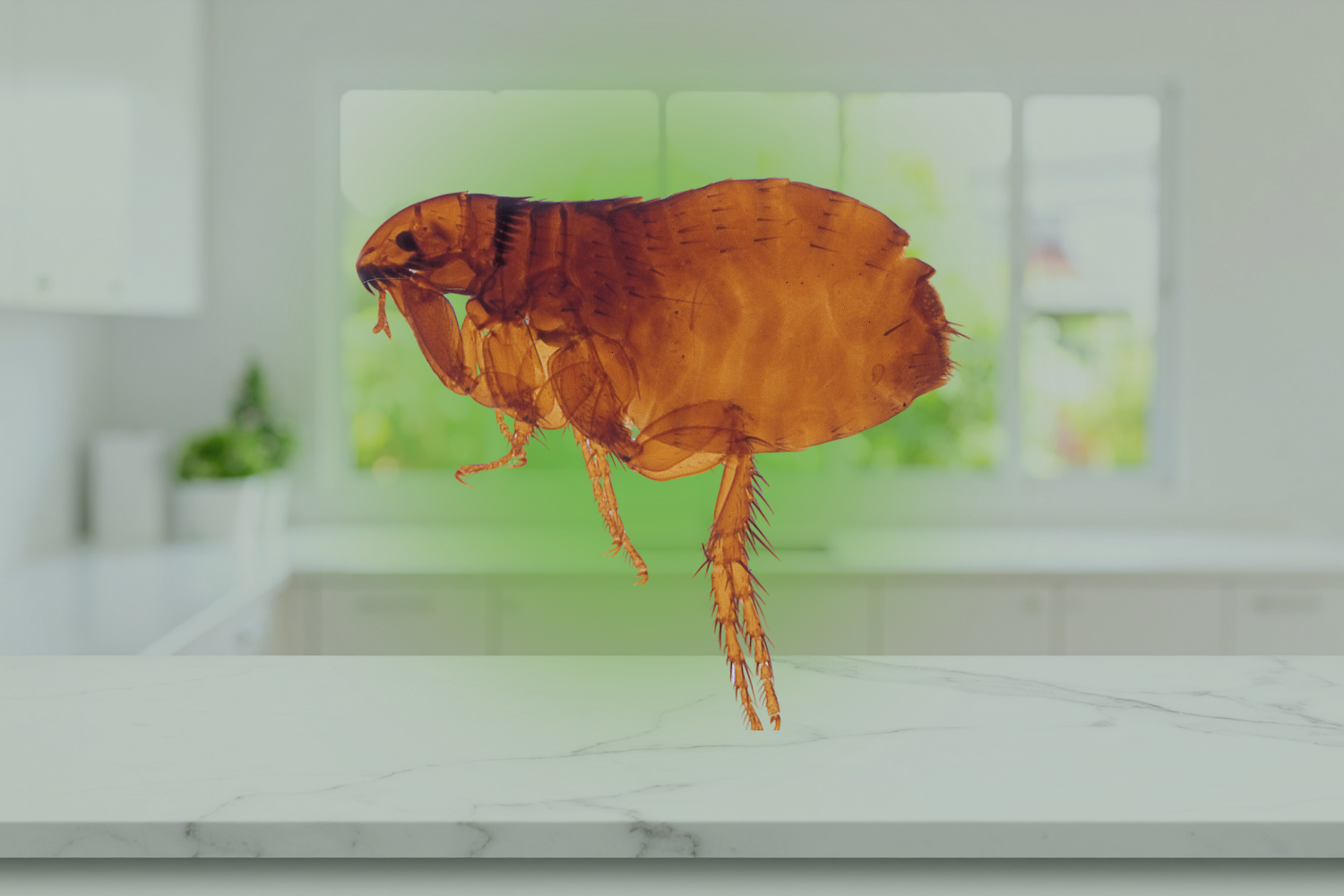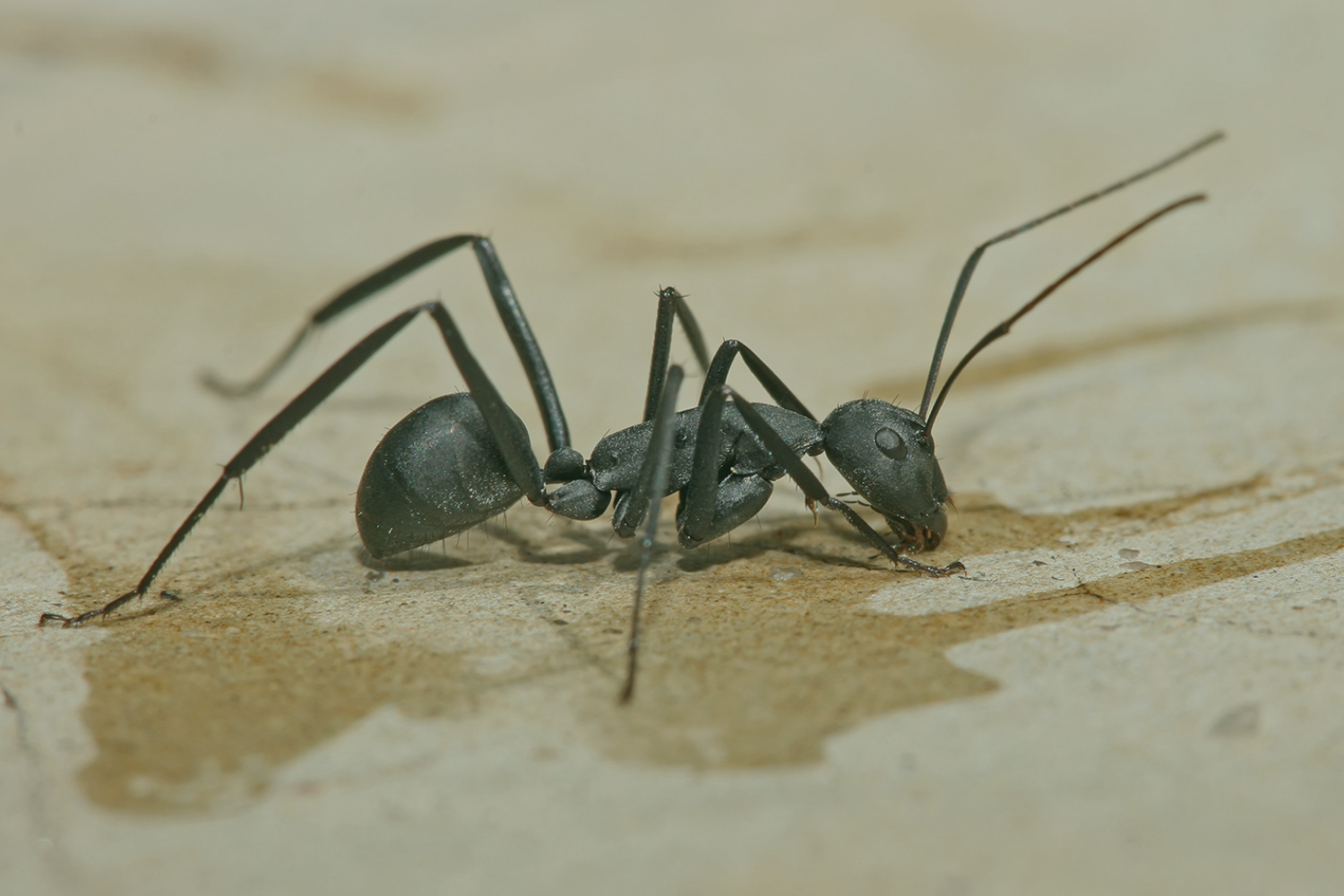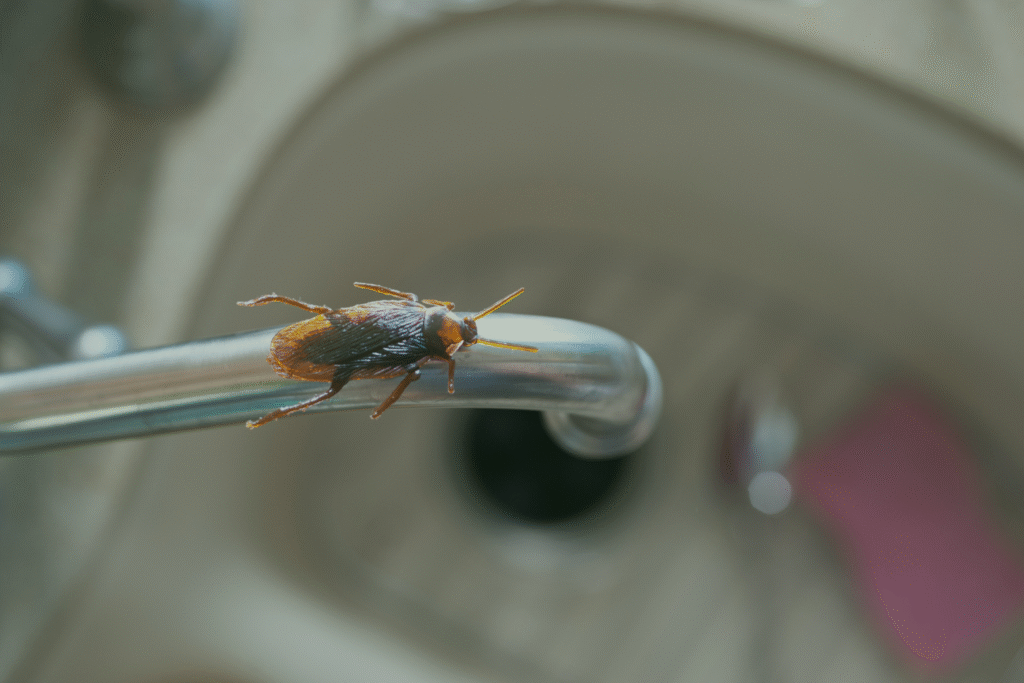
Few things make a homeowner’s heart sink like spotting a cockroach scurrying across the floor. These fast, sneaky pests can show up in even the cleanest homes and multiply at an alarming rate. Learning how to get rid of cockroaches at home and keep them away for good is key to maintaining a clean, healthy living space.
Cockroaches don’t just make you uncomfortable; they’re known to spread harmful bacteria like E. coli and Salmonella, contaminate food, and trigger asthma and allergy symptoms. Unfortunately, a few store-bought sprays or traps usually aren’t enough to solve the problem.
This guide will show you how to identify where cockroaches are hiding, how to eliminate them effectively, and most importantly, how to prevent them from ever coming back.
Why Cockroaches Are So Hard to Get Rid Of
Cockroaches have been around for more than 300 million years, which means they’ve perfected the art of survival. Their anatomy and behavior make them extremely difficult to eliminate once they’ve moved in.
Here’s what makes roaches so tough to control:
- They can survive without food or water for weeks. A roach can live up to a month without food and still hide comfortably in small crevices until resources return.
- They breed rapidly. A single female German cockroach can produce several egg cases every few weeks, each containing up to 40 eggs. Within months, a few roaches can turn into hundreds.
- They hide in hard-to-reach places. Cockroaches prefer dark, humid environments such as behind refrigerators, under sinks, and inside wall voids.
- They can develop pesticide resistance. Over generations, cockroaches can adapt to survive certain insecticides, making DIY products less effective.
- They’re nocturnal. Roaches mostly come out at night, so by the time you see one in daylight, there’s likely a full infestation hidden nearby.
How to Identify a Cockroach Infestation Early
The earlier you detect roaches, the easier it is to eliminate them. Unfortunately, many homeowners overlook the signs until the infestation becomes advanced.
Here’s how to recognize early activity:
1. Droppings
Small, pepper-like specks in cabinets, drawers, or near food sources are a sure sign of roaches. The droppings often collect in corners or under appliances.
2. Egg Cases (Oothecae)
Roach eggs are enclosed in a brown capsule, usually about ¼ inch long. You might find them stuck behind furniture, under sinks, or even inside pantry boxes.
3. Shed Skins
As roaches grow, they shed their exoskeleton several times. Finding these paper-like shells near baseboards or behind the fridge is a strong indicator of an active infestation.
4. Musty Odor
Large infestations produce a distinct, oily, musty smell caused by pheromones. This odor often lingers even after cleaning.
5. Live or Dead Roaches
Spotting one cockroach during the day usually means many more are hiding. Roaches prefer darkness and only come out in daylight when overcrowded.
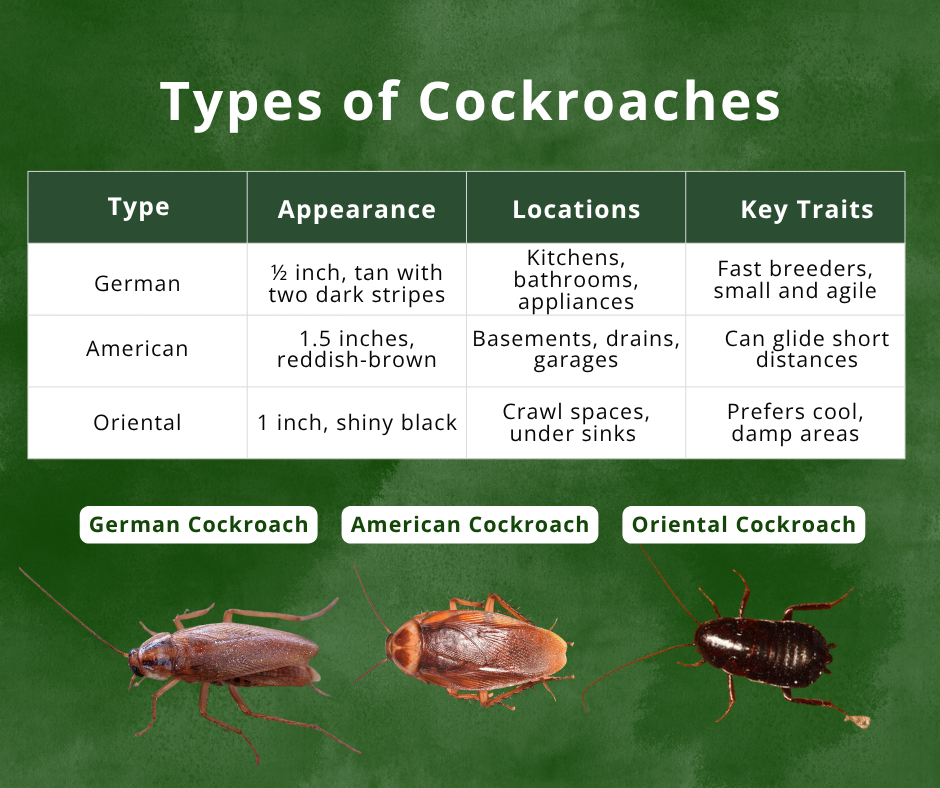
Why Cockroaches Keep Coming Back
If you’ve cleaned, sprayed, and set traps but the roaches keep returning, you’re not alone. The truth is, cockroaches are experts at hiding and repopulating. Understanding why they reappear is the first step toward breaking the cycle.
1. Hidden Eggs Survive Treatments
Most DIY sprays only kill adult cockroaches. The eggs often remain untouched in hidden crevices. Once they hatch, the infestation begins again.
2. Moisture Sources Go Unchecked
Roaches can’t survive long without water. Even small drips under a sink or condensation on pipes can sustain them. If the moisture issue remains, they will return.
3. Incomplete Cleaning or Missed Food Sources
A few crumbs behind the stove or residue in a garbage bin can attract a new generation of roaches. Consistency in cleaning is essential.
4. Neighboring Infestations
In multi-unit housing or duplexes, cockroaches can migrate between units through plumbing or shared walls. This is why community pest control is sometimes needed.
5. Limited Access to Professional-Grade Treatments
Store-bought sprays and traps rarely reach every area of infestation. Professional pest control targets roaches at every stage, using baiting systems and residual treatments that continue working for weeks.
How to Get Rid of Cockroaches at Home Fast
When you find cockroaches, you need both immediate action and a longer-term plan. The goal is not only to kill the visible roaches but also to disrupt their breeding cycle.
Here’s a proven, professional-style method you can use at home:
Step 1: Deep Clean Everything
Start by cleaning the kitchen and bathroom thoroughly. Focus on grease, crumbs, and spills. Wipe down baseboards, mop floors, and sanitize counters. Pull out large appliances like the stove and refrigerator to clean underneath.
Step 2: Starve Them Out
Store food in sealed containers. Keep pet food in tight bins and avoid leaving it out overnight. Empty trash cans daily, especially those containing food waste.
Step 3: Use Bait Stations and Gel Baits
Gel baits are more effective than sprays because they attract roaches to feed. Place baits near high-traffic areas such as behind the refrigerator, along cabinet edges, and under the sink. Roaches carry the poison back to their nests, spreading it to others.
Step 4: Apply Boric Acid or Diatomaceous Earth
Lightly dust dry, hidden areas such as baseboards, cracks, or behind cabinets. Boric acid and diatomaceous earth are highly effective contact killers that dehydrate roaches over time.
Step 5: Seal Cracks and Entry Points
Cockroaches can squeeze through gaps as small as 1/16 of an inch. Use silicone caulk or weather stripping around pipes, vents, and door frames.
Step 6: Control Humidity and Leaks
Dry environments discourage cockroaches. Fix leaks under sinks, keep bathroom floors dry, and run exhaust fans after showers.
Step 7: Repeat and Monitor
It may take several weeks to see full results. Replace baits every two weeks and reapply dust as needed. Keep an eye on activity using sticky traps to track progress.
What Not to Do When Trying to Get Rid of Cockroaches
It’s tempting to grab a can of bug spray and hope for the best, but certain mistakes can make infestations worse.
Common DIY Mistakes to Avoid:
- Overusing aerosol sprays: Sprays may kill a few roaches, but push others deeper into hiding.
- Using bleach or vinegar as pesticides: These clean surfaces but don’t kill roaches or their eggs.
- Blocking roaches from bait: Spraying over baited areas discourages roaches from approaching.
- Ignoring hidden moisture: Even one small leak can sustain a colony.
- Skipping follow-ups: Roaches multiply quickly, so missing a few eggs can restart the problem.
A study from the Journal of Economic Entomology found that homes treated with professional baiting programs saw a 90% reduction in roach populations within 30 days, compared to only 40% for DIY methods.
Best Natural and Pet-Safe Ways to Get Rid of Cockroaches
If you prefer eco-friendly options or have children and pets, natural remedies can play a role in controlling roaches, especially when combined with preventative cleaning.
Effective Natural Solutions:
- Baking Soda and Sugar Trap – Mix equal parts sugar and baking soda, then place small amounts in shallow dishes near roach trails. The sugar attracts them while the baking soda reacts with stomach acid to kill them.
- Essential Oils – Add 10 drops of peppermint or eucalyptus oil to a spray bottle filled with water. Mist along baseboards, under sinks, and near entry points to repel roaches.
- Citrus Peels – Roaches dislike the smell of citrus. Wipe surfaces with lemon or orange-scented cleaners.
- Diatomaceous Earth (Food Grade) – Sprinkle light layers in dry, hidden areas. It’s safe for people and pets but deadly to insects that crawl over it.
While these methods are safe, they typically won’t eliminate a severe infestation. For best results, pair natural strategies with professional treatment to completely eradicate roaches.
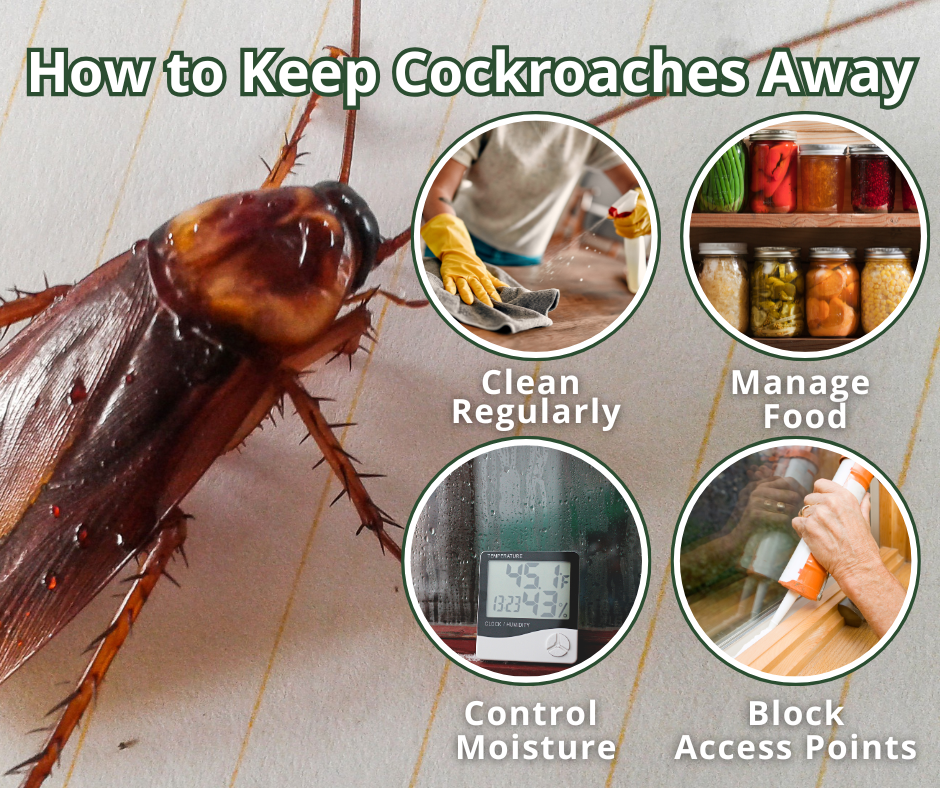
How to Keep Cockroaches Away for Good
Eliminating cockroaches is only half the battle. The key to staying roach-free is consistent prevention.
1. Clean Regularly and Consistently
- Wash dishes immediately after meals.
- Sweep and vacuum floors daily.
- Clean behind stoves, fridges, and cabinets monthly.
- Keep sink drains dry overnight.
2. Manage Food Storage
- Store dry goods like rice, flour, and cereal in sealed containers.
- Avoid leaving pet food bowls filled overnight.
- Keep counters and stovetops free of crumbs and grease.
3. Control Moisture and Humidity
- Repair leaks and dripping faucets promptly.
- Use dehumidifiers in damp basements or laundry areas.
- Wipe condensation from windows and bathroom mirrors.
4. Block Access Points
- Seal cracks around walls, windows, and doors.
- Install door sweeps and screen vents.
- Use expanding foam or silicone caulk for pipe gaps.
5. Schedule Professional Inspections
Even if your home looks spotless, small infestations can develop unnoticed. Scheduling regular inspections with Bigfoot Pest Management ensures early detection and long-term protection.
Related Questions
What’s the Fastest Way to Get Rid of Cockroaches Overnight?
The fastest way is to use gel baits. Roaches feed on the gel, return to their nests, and spread the poison to others. Vacuum up any dead insects the next morning to prevent secondary contamination.
Can Cleaning Alone Get Rid of Cockroaches?
Cleaning helps by removing food and water sources, but it won’t kill the roaches hiding inside walls or furniture. Combine cleaning with baiting and professional treatments for lasting results.
Are Professional Treatments Safe for Pets and Kids?
Yes. Bigfoot Pest Management uses family-safe, pet-safe treatments that are EPA-approved and applied in targeted areas where pests hide, not where families live.
When to Call a Professional Pest Control Company
If you’re still seeing cockroaches after a couple of weeks of cleaning and baiting, it’s time to call in the experts. Professionals have access to more powerful tools and techniques that eliminate infestations.
You should contact Bigfoot Pest Management if:
- You see cockroaches during the daytime.
- Droppings or egg cases appear in multiple rooms.
- There’s a persistent musty odor.
- DIY sprays or traps are no longer working.
Our technicians don’t just treat the problem, they identify the cause, seal entry points, and provide recommendations to prevent future infestations.
Conclusion
Getting rid of cockroaches takes time, persistence, and the right strategy. Start by identifying the problem areas, removing food and water sources, and applying bait treatments strategically.
However, for lasting results, partner with a trusted professional like Bigfoot Pest Management. Our local expertise, proven methods, and commitment to safe pest control ensure your home stays clean, comfortable, and cockroach-free year-round.
What Does a Home Infestation of Fleas Look Like?
An infestation of fleas looks like repeated bites on people or pets, constant scratching, and small dark insects jumping from carpets, furniture, or pet bedding.…
Read MoreWhat Do Carpenter Ants Look Like in Washington Homes?
When homeowners ask what do carpenter ants look like in Washington homes, the answer is simple. Carpenter ants are large black or dark red ants…
Read More



